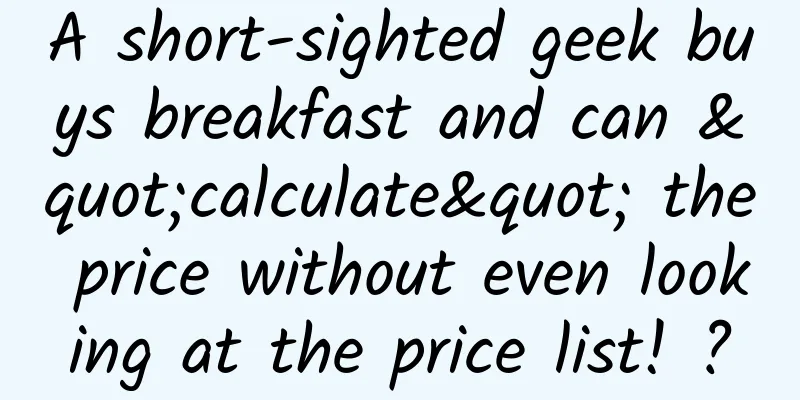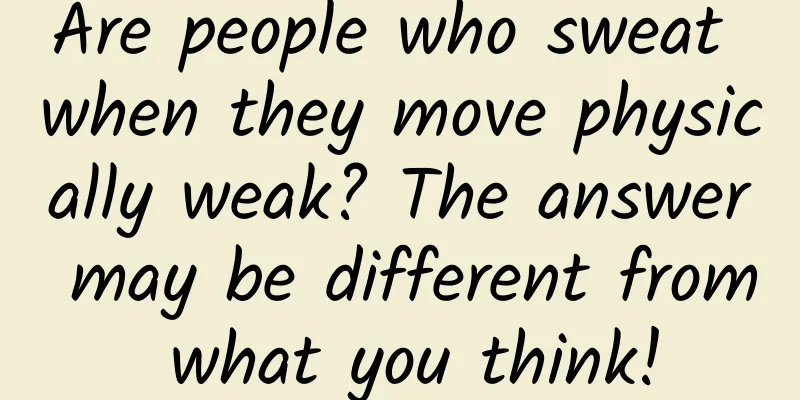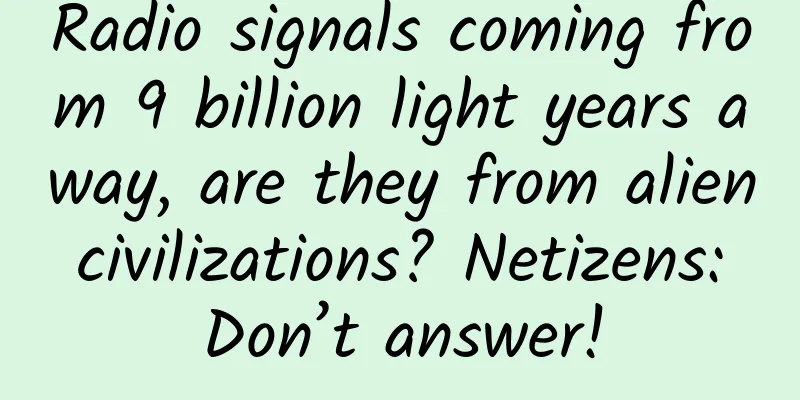A short-sighted geek buys breakfast and can "calculate" the price without even looking at the price list! ?

|
Many students feel confused and painful when they first learn linear algebra, and they cannot appreciate the practical significance of the course. This is largely because the textbooks must start from basic abstract concepts in order to go from the shallow to the deep and step by step, and the truly intuitive part often has to wait until the later subdivisions or specific applications. Therefore, beginners often know the results but not the reasons; they only see the trees but not the forest. I hope this article can help you change your perspective and see a different linear algebra with a relaxed and interesting daily perspective. This article is the third in a series of articles titled "Linear Algebra in N Texts". In the previous article, we introduced the inverse of a matrix and its properties through elementary matrix transformations, and discussed the process of solving a system of linear equations. There are only three possible solutions to a system of linear equations: no solution, a unique solution, or infinite solutions. So, what are the rules? Written by | Wu Jinyuan In the last chapter, a nearsighted otaku went downstairs to a breakfast shop to buy breakfast one day. He forgot his glasses at home and couldn't see the price list on the blackboard. So, while waiting in line, the otaku listened to the number of breakfast items purchased by the customer in front of him and the total price reported by the waitress, and calculated the unit price of various breakfast items based on this. Figure 1 After collecting data, analyzing and calculating, the myopic otaku found the inverse matrix of the coefficient matrix of the linear equation system, calculated the unit price of food, and bought breakfast. While eating, he fell into deep thought. (1) How many transactions determine the outcome? We know that only square matrices can be inverted. Specifically, in our breakfast problem, there are three unknowns, and we need exactly three transactions, or three linear equations, to find the unknown unit price of food. But in the real world, we may not have exactly three transactions. In these cases, what problems will our calculations encounter? Intuitively, we know that if the number of equations is less than the number of unknowns, there is no way to find a unique solution. But if the two are equal, can we find a unique solution? Furthermore, what if the number of equations is greater than the number of unknowns? Let's analyze it step by step: In order to discuss these issues intuitively, we plot the unit prices of the three foods in a three-dimensional coordinate system. In the following figures: The horizontal direction is the unit price of oil cake x1, The vertical direction is the price of tea eggs x2. The unit price of tofu pudding x3 points beyond the paper. Figure 2 The figure above shows a plane (red), which is the graph of the first equation in the system of linear equations, that is, the transaction made by the first customer. The customer bought a fried dough cake, a tea egg and a bowl of tofu pudding, with a total price of 14 yuan. Based on the first transaction alone, we obviously cannot calculate the unit price of the three foods, but we still get some information. Specifically, we know that the unit price of these three foods must be at a certain point on this plane. For example, this plane intersects the horizontal axis at the point x1=14, which corresponds to a fried dough stick for 14 yuan, while tea eggs and tofu pudding are free. Although few bosses set prices this way in reality, the unit price corresponding to this point does not contradict this equation. In fact, all points on the entire plane do not contradict this equation, and the actual unit price is also on this plane, which is the blue dot marked in our figure. Indeed, knowing only one transaction, or one equation, we do not have enough information to determine the true unit price. Now we introduce the second transaction, and this equation corresponds to another plane (green) in Figure 3. Figure 3 This plane intersects the first plane on a straight line. This means that the unit price combination that satisfies both equations can only be on this line. Although the real unit price combination is indeed on this line, we still cannot confirm its exact location. There are still infinite solutions that meet both equations at the same time. Obviously, we need to introduce the third transaction. The linear equation corresponding to the third transaction corresponds to the purple plane in the figure below. Figure 4 This new plane intersects the previous two planes at a common point in space, which is the true unit combination in this problem. Therefore, if there are N unknowns, there must be at least N equations to find a unique solution. So, does it mean that if the number of equations is equal to the number of unknowns, then a unique solution can be found? Not necessarily. Suppose in the example of buying breakfast, the otaku did not hear the transaction data of customer 3 clearly, and only used the transaction data of customers 1, 2, and 4 to solve the problem, he would not be able to get a unique solution. For the convenience of readers, we have re-listed the purchase data of several customers in the following table: If you observe carefully, you will find that the transaction data of customer 4 is a linear combination of the data of customers 1 and 2: 5×(customer 1 data)-(customer 2 data). Therefore, the data of customer 4 does not provide any new information. This equation corresponds to the purple plane in Figure 5. This plane intersects with the previous two planes on the same straight line, and all points on this line satisfy the three equations at the same time. Figure 5 It is not difficult to imagine that even if we add several more equations, if the newly added equations are linear combinations of the original equations, the newly added equations still cannot provide new information or new constraints, so the unique solution cannot be obtained. These equations are drawn in the figure above as a set of planes, and these planes intersect on a common straight line. (2) Things about Order The properties of the solutions to the linear equation system Ax = y are closely related to the rank of the matrix A. The rank refers to the maximum number of linearly independent rows or columns in a matrix. In the breakfast example above, the three transactions of customers 1, 2, and 3 are linearly independent of each other, so the rank of this matrix is rank( A ) = 3. If we do not include customer 3 and only consider the transactions of customers 1, 2, and 4, we can only find two linearly independent rows, and the third row is just a linear combination of the first two rows. Therefore, the rank of such a matrix is rank( A ) = 2. The number of columns m of a matrix corresponds to the number of unknowns in the system of equations, and its rank ( A ) is the maximum number of linearly independent equations, which can also be seen as the number of constraints that can provide independent information. When rank ( A ) = m, we call this situation full column rank, and if the system of equations has a solution, then its solution is unique. If rank(A)<m, we call this situation under-rank. If the system of equations has a solution, its solution is not unique, but there are countless solutions. If a matrix is "short and fat", or has fewer rows than columns, then it obviously cannot be full column rank. The system of equations corresponding to a "short and fat" matrix has no unique solution, or if it has a solution, there are infinite solutions. When the number of rows is greater than the number of columns, the matrix becomes "tall and thin", and the corresponding system of equations may have a unique solution (if there is a solution). However, under the premise of having a solution, the specific situation depends on whether it is full rank. These two situations are easy to understand through the previous examples. (3) What does “no solution” mean? Readers may ask, why do we emphasize "if the system of equations has a solution"? Is there a situation where the system of equations has no solution? Indeed, there is. In a system of equations, each equation added may add a constraint. In this way, in an ideal situation, there are enough effective constraints to help us find the solution of the system of equations. Continuing to add equations can help us verify whether the previous calculations are correct. However, when we add equations to a system of equations, it is entirely possible that we may create confusion and add self-contradictory equations. In this case, the system of equations has no solution. For example, in the breakfast example, the first customer bought a fried dough cake, a tea egg, and a bowl of tofu pudding, and the waitress quoted 14 yuan. Suppose another customer bought two fried dough cakes, two tea eggs, and two bowls of tofu pudding, then the price should be 28 yuan. Assuming the customer is Cantonese, the waitress kindly pronounces it according to Cantonese, so our otaku may mistake "twenty-eight" for "one thirty-eight". In this way, we have encountered a self-contradictory system of equations. In the real world, errors in data collection and transmission are very common, so it is also very common for the equation system to contradict itself, and the contradictions may be very complicated. In order to find out whether the equation system has a solution, we need to use the rank of another matrix: the rank of the augmented matrix ( A | y ) rank ( A | y ). The augmented matrix mentioned here is the combination of y and A in the equation system Ax = y . Here, y is a vertical column of numbers, which can be regarded as a vector. And each column in A is also a vector of the same dimension. It is not difficult to see that if the system of equations Ax = y has a solution, then y must be a linear combination of the column vectors in A. We add y to A , and the newly added column is linearly related to the other columns. In this way, the rank( A | y ) of the augmented matrix ( A | y ) will not be greater than the rank( A ) of the original matrix A. Therefore, the system of equations having a solution is equivalent to rank( A | y )=rank( A ). On the contrary, if the rank increases after adding a column, that is, rank( A | y )=rank( A )+1, then the system of equations must be self-contradictory and have no solution. If we list the situations we discussed above in a table, it will become clear at a glance. It should be pointed out here that when the matrix A is not full rank, if the equation has a solution, there will be infinite solutions, but the "infinite" in different situations is different. Specifically, the dimension of the solution space is equal to m-rank( A ). For example, in our breakfast example, m = 3. When there is only the first customer data, rank ( A ) = 1, then the solution space is a plane, and the dimension of the solution space is equal to (m-rank ( A )) = 3-1 = 2. After the data of the second and even the fourth customer are added, rank( A )=2. At this time, the dimension of the solution space is equal to 3-2 = 1, and the solution space is a straight line. When the data of the third customer is added, rank ( A ) = 3. At this time, the dimension of the solution space is equal to 3-3 = 0, so the solution space becomes a point, the number of solutions changes from infinite to 1, and the equation has a unique solution. (4) Zero-dollar purchase and homogeneous linear equations Sometimes we encounter homogeneous linear equations, that is, Ax = 0. "Homogeneous" means that there are only first-order terms of the unknown number x in the equation, no constant terms, or no 0-order terms of the unknown number x, so the powers of each term are "homogeneous". Since the right side of the system of equations is equal to 0, the rank of its augmented matrix will obviously not increase. Therefore, the homogeneous linear system of equations must have a solution, and we can see with the naked eye that x = 0 is obviously a solution to the equation. But the question is, in addition to the trivial solution x = 0, will the homogeneous linear system Ax = 0 have any solutions other than 0? From the previous discussion, we know that when rank( A ) < m, the system has infinite solutions, so the homogeneous linear system does have non-zero solutions. To make it easier to understand, we draw the following figure. Each plane in the figure is equivalent to a linear equation. The equations corresponding to these three planes are linearly independent. The constant term on the right side of each equation is equal to 0, and its geometric meaning is that each plane passes through the origin. Figure 6 In the figure above, the three planes have only one common intersection point, which is the origin. Therefore, when rank( A )=m, the system of equations has a unique solution, that is, there is only one trivial solution, x = 0. If the equations corresponding to the three planes are linearly related (e.g., rank equals 2), the spatial relationship between them might look like this: Figure 7 Since the right side of each equation is also equal to 0, each plane also passes through the origin. However, since the three equations are linearly related, the three planes have infinitely many common points. When the rank is equal to 2, these common points form a straight line that also passes through the origin. In this way, except for the trivial solution x = 0, other places on this line are also solutions to the system of equations, or in other words, this homogeneous linear system of equations has non-zero solutions. In real numbers, only 0 multiplied by a number will produce a product of 0. Therefore, it is sometimes difficult for us to imagine non-zero solutions. In fact, when a bunch of numbers that are not completely 0 are multiplied by another bunch of numbers that are not completely 0, their products added together may indeed produce a 0. This situation is not difficult to happen. For example, as long as the products of the two sets of numbers are positive and negative after multiplying, they may completely cancel each other out and become 0. For example, when all numbers that are not equal to 0 are perfectly missed during matrix multiplication, and are all multiplied by 0, the result is also 0. In linear algebra, a matrix with all elements equal to zero is called a zero matrix. Multiplying a zero matrix with any matrix will naturally result in a zero matrix, but the reverse is not necessarily true. In fact, it is entirely possible to multiply two non-zero matrices to obtain a zero matrix. A homogeneous linear system of equations with non-zero solutions is actually an example of multiplying two non-zero matrices to obtain a zero matrix. What will happen to the homogeneous linear equations in our breakfast purchase example? First of all, our otaku heard that the results of all previous transactions were 0, so he could imagine that this "zero-yuan purchase" was a very happy situation. In the past, the canteens of schools or units, sometimes because of the good management of the administrators, could often purchase cheap ingredients at the vegetable market, and there would be a lot of surplus in a year, so there would be a day of "eating surplus" at the end of the year. Obviously, if the unit price of all foods is 0, there will be a result of eating surplus or zero-yuan purchase. But the reverse is not necessarily true. For example, based on the purchase data of the following two customers, we cannot confirm that the unit price of all food is 0: The first customer bought a fried dough cake, a tea egg, and a bowl of tofu pudding for 0 yuan; The second customer bought two fried dough cakes, four tea eggs, and four bowls of tofu pudding for 0 yuan. Because except for the case where all food is free, it is entirely possible to find non-zero solutions that make these two equations true. For example, imagine: The unit prices of fried cakes, tea eggs, and tofu pudding are 0 yuan, X yuan, and -X yuan, so the above two equations are valid. This set of unit prices means that fried cakes are free, tea eggs are X yuan each, and buying a bowl of tofu pudding is not only free, but also comes with a gift certificate worth X yuan. This situation does not sound very reasonable in business, but in theory, it is a non-zero solution to the homogeneous linear equation system. Now, if we add the third customer's data: Suppose he bought a fried dough cake, three tea eggs, and three bowls of tofu pudding for 0 yuan; We still cannot confirm that the unit price of all foods is 0. This is because his purchase quantity vector is a linear combination of the first two digits (the second purchase quantity vector - the first purchase quantity vector). Only when the purchase quantity vector of a returning customer is linearly independent of the previous ones, and the entire matrix becomes full rank, can we obtain the unique solution to the new system of equations, that is, all unit prices are 0. (To be continued) Special Tips 1. Go to the "Featured Column" at the bottom of the menu of the "Fanpu" WeChat public account to read a series of popular science articles on different topics. 2. Fanpu provides a function to search articles by month. Follow the official account and reply with the four-digit year + month, such as "1903", to get the article index for March 2019, and so on. Copyright statement: Personal forwarding is welcome. Any form of media or organization is not allowed to reprint or excerpt without authorization. For reprint authorization, please contact the backstage of the "Fanpu" WeChat public account. |
>>: Your child has trouble concentrating? See how the Mengzi family handles it...
Recommend
Even refrigerators have pop-up ads. Has Yunmi gone astray on the road to smart home?
Nowadays, the concept of interconnection between ...
Can "rice" cure sprained ankles? Don't disbelieve it, it's true!
Author: Zhou Mouwang, Chief Physician, Peking Uni...
How serious are the consequences if spies steal hybrid rice seeds in my country?
Recently, the Ministry of State Security disclose...
Isn’t cholera a Class A infectious disease? Why are the cases at Wuhan University not dangerous?
For the same cholera, some strains may be just &q...
New media operations: 12 sober reflections on the suspension of updates on “WeChat, Weibo and Douyin”!
In the past two days, there has been a discussion...
Three steps to write an iOS network request library yourself
Code example: https://github.com/johnlui/Swift-On...
Why should we practice Code Kata?
[[155877]] background The concept of Code Kata wa...
The Hotan-Ruoqiang Railway officially opens to traffic today, encircling the Taklimakan Desert
June 16 Hotan-Ruoqiang Railway (hereinafter refer...
When shampoo is used up, can I use shower gel instead? The answer is confusing...
In daily life, we will inevitably encounter some ...
Mourinho's view on the hot money model focusing on leading stocks column video
Mourinho's market-watching hot money model fo...
Cold Dew: Do you listen to the "Autumn Johns Song" or follow the "Autumn Freeze" principle?
There is a proverb that goes, "After eating ...
45 essential things to know about community operations!
Be patient, take it slow and it will be faster. I...
Dangbei X3 laser projector: automatic focus, bringing the cinema home, allowing you to watch blockbusters during the day
When it comes to projectors, perhaps many people&...
Why do glasses become crooked when I wear them?
This article was reviewed by Dr. Tao Ning, Associ...
Changba: How to discover, support, produce and retain users?
The mobile KTV application Changba has been in op...









